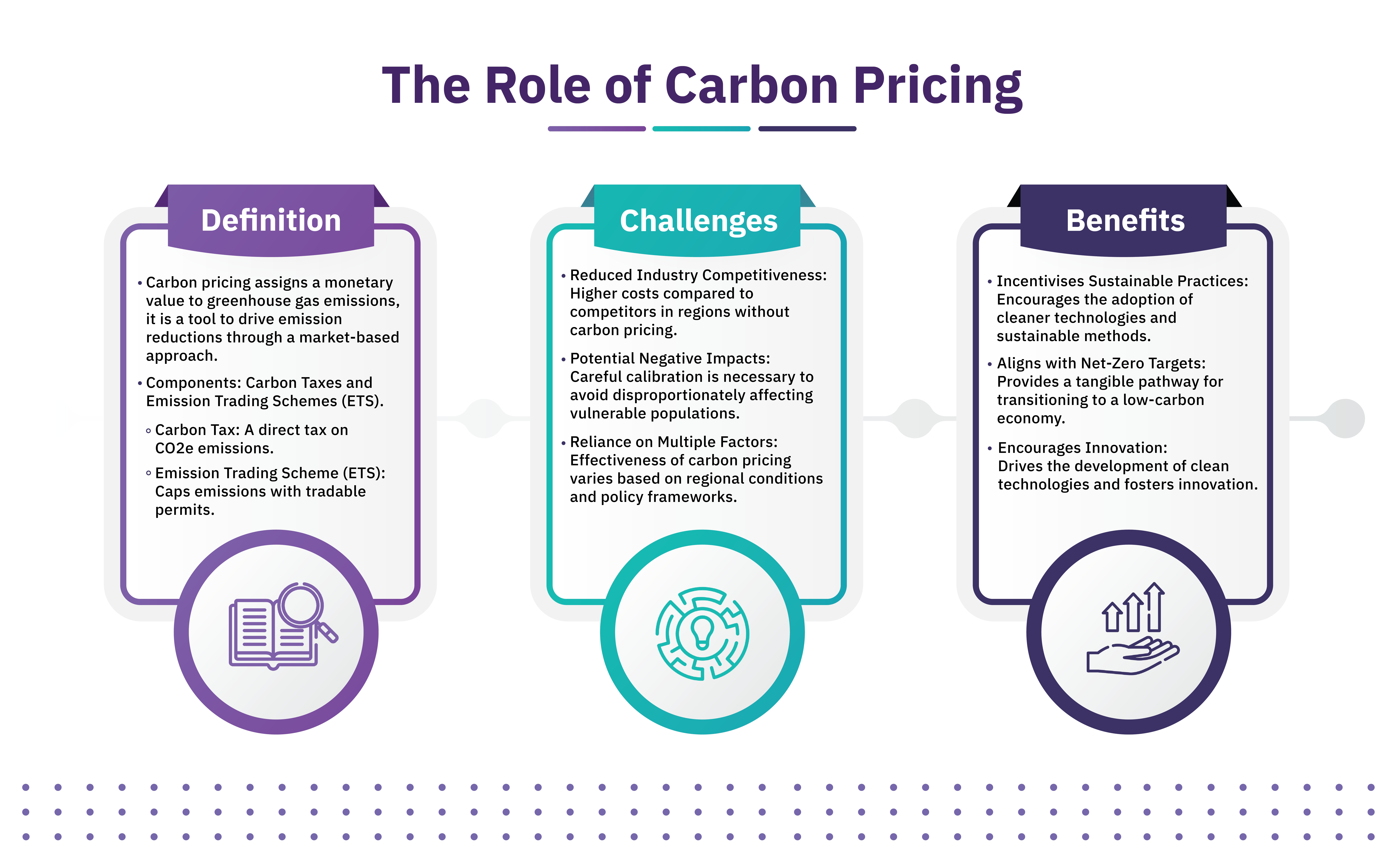Summary
- Carbon pricing is a market-based mechanism that assigns a monetary value to carbon dioxide and other greenhouse gas emissions, reflecting the environmental cost of these emissions. It operates on the principle of externality - assigning monetary cost to a given economic activity that affects a third party that is not directly related to that activity.
- Carbon pricing can be a catalyst for sustainable practices, incentivising businesses to embrace greener technologies and processes. Businesses investing in sustainability can gain a competitive edge, appealing to environmentally conscious consumers and potentially securing long-term benefits while reducing regulatory risks.
- Investing in comprehensive carbon measurement and management can help companies manage their carbon emissions more efficiently.
Introduction
In the battle against climate change, finding effective strategies to reduce greenhouse gas emissions has become paramount. Carbon pricing has emerged as a powerful instrument in driving emission reductions. Carbon pricing aims to put a price on carbon emissions, creating economic incentives for businesses and individuals to reduce their carbon footprint. This article delves into the role of carbon pricing in reducing CO2e emissions, exploring its mechanisms, impact on various sectors, challenges, and an innovative solution for effective implementation.

What is carbon pricing?
Carbon pricing is a market-based mechanism that assigns a monetary value to carbon dioxide and other greenhouse gas emissions, reflecting the environmental cost of these emissions. It operates on the principle that if activities emitting carbon are financially penalised, enterprises will be pushed to seek cleaner alternatives, thereby reducing their carbon footprint. The two main instruments of carbon pricing are carbon taxes and emission trading schemes (ETS).
A carbon tax involves placing a direct tax on greenhouse gas emissions. This provides a clear motivation for entities to lower their emissions as it directly impacts their bottom line. On the other hand, an emission trading scheme establishes a “cap-and-trade” system which puts a cap on total emissions within a jurisdiction and allocates tradable emission permits to companies. Companies that exceed their allocated limits can purchase extra permits from those that have effectively reduced their emissions below their allocated thresholds.
In its annual State and Trends of Carbon Pricing report in 2023, the World Bank reported that almost a quarter of global greenhouse gas emissions (23%) are now covered by 73 carbon pricing instruments. This is a marked change from when the first edition of this report was published in 2013, where only 7% of global emissions were covered by either a carbon tax or an emission trading system (ETS). This rise underscores a growing global commitment towards embracing carbon pricing as a fundamental strategy for addressing climate change.
The role of carbon pricing in reducing CO2e emissions
Carbon pricing has a significant impact on businesses, as it aims to internalise the external costs of carbon emissions. Businesses face increased operational expenses, which can lead to higher production costs and reduced profit margins, particularly for carbon-intensive industries. On the other hand, it also acts as a catalyst for sustainable practices, incentivising businesses to embrace greener technologies and processes, thereby diminishing their reliance on fossil fuels and minimising carbon emissions. As a result, businesses investing in sustainability gain a competitive edge, appealing to environmentally conscious consumers and potentially securing long-term benefits while reducing regulatory risks.
Carbon pricing offers a multifaceted approach to driving emission reductions and fostering sustainable practices. Economic incentives play an important role in steering industries and individuals towards cleaner practices. The prospect of reduced operational costs encourages companies to invest in renewable energy sources, energy efficiency, and emission measurement technologies like Terrascope. Governments are similarly motivated to implement carbon pricing as it aids them in achieving their national net-zero targets while generating revenue to fund climate initiatives. For example, Indonesia’s new ETS, established in 2023, will function as a hybrid “cap-tax-and-trade” system. Facilities that fail to meet obligations will be subject to a tax - the rate of which will eventually be linked to the price of the domestic carbon market.
Supporting global net-zero targets, carbon pricing offers a tangible avenue for companies and governments to steer the transition toward a low-carbon economy.
How carbon pricing affects CO2e emissions in various sectors
The impact of carbon pricing extends across a range of sectors, each contributing to varying extents of global CO2e emissions. In the power sector, carbon pricing transforms the energy landscape by steering investments towards renewable sources such as solar, wind, and hydropower. Fossil fuel-based power generation becomes costlier, prompting a shift towards cleaner alternatives. The industrial sector has been witnessing a shift towards cleaner production methods, energy efficiency improvements, and carbon capture technologies. Lastly, the buildings sector is driven to implement energy-efficient designs, materials, and technologies to reduce emissions from heating, cooling, and electricity consumption.
Carbon Pricing Challenges
Despite its potential, carbon pricing faces several challenges:
- Reduced industry competitiveness: Carbon pricing has faced resistance from some sectors due to concerns over reduced competitiveness in global markets. Businesses subjected to carbon pricing might face higher costs compared to competitors in regions without such measures.
- Potential negative impacts: Careful calibration is required to avoid disproportionately affecting vulnerable populations. Elevated energy prices may restrict essential spending on necessities such as food, healthcare, and housing, while also contributing to job losses in energy-intensive industries and heightening economic challenges for these communities.
- Reliance on multiple factors: Carbon pricing is not a quick fix that automatically leads to emissions reduction. Its efficiency can vary depending on regional economic conditions and policy frameworks. At the same time, a broader portfolio of measures is needed to achieve substantial emission reductions in line with global climate goals.
Investing in comprehensive carbon measurement and management can help businesses accurately track and reduce their emissions, mitigating the cost impact and enhancing their competitive edge. Carbon measurement plays a vital role in supporting sustainability efforts by offering the means to monitor progress, identify opportunities for reduction, and implement sustainable practices alongside carbon pricing initiatives.
The Terrascope solution
Terrascope’s carbon measurement and management platform offers enterprises a chance to reduce their greenhouse gas emissions, and hence lower the amount of carbon tax which they need to pay. By providing businesses with accurate and granular data on their carbon emissions, Terrascope empowers enterprises to gain a comprehensive and granular understanding of their emissions footprint. This enables them to analyse emissions hotspots and implement the most appropriate decarbonisation levers.
Terrascope's data-driven insights not only support internal decision-making but also enable businesses to make more accurate claims about their environmental impact. This level of transparency and accountability can limit greenwashing and foster consumer trust and loyalty, further incentivising sustainable practices across industries.
The platform also fosters collaboration within and beyond organisations, facilitating data gathering, reduction initiatives and progress tracking. This is achieved by monitoring progress against long-term and intermediate targets with shared dashboards and reporting through seamless integrations.
Be the first to know.
Join us on LinkedIn to get curated updates monthly.
Conclusion
Carbon pricing is a crucial tool in the fight against climate change, harnessing market forces to drive emission reductions. Tech solutions like the Terrascope platform offer promising pathways for companies to measure and reduce their greenhouse gas emissions. As the world continues to grapple with the urgency of climate action, carbon pricing can play a key role in building a more sustainable and resilient future.



